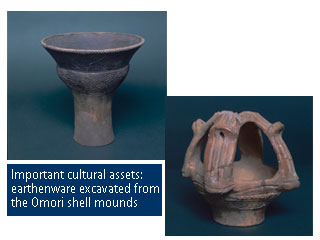Celebrating the 130th Anniversary of the Excavation of the Shell Mounds of Omori and the 60th Anniversary of Shinagawa City
Shinagawa Historical Museum’s Special Exhibition
This year marks the 130th anniversary of the excavation of the Omori shell mounds by American zoologist Edward S. Morse in 1877. To commemorate this event, a special exhibition entitled “Japanese Archeology Began in Shinagawa—The Shell Mounds of Omori and the Mounds of Tokyo” is being held at the Shinagawa Historical Museum. The exhibition displays various items unearthed at the Omori shell mounds and show how the excavation and research was conducted. It also displays materials collected by Kumagusu Minakata, a famous natural historian, and introduce the attractive aspects of mounds in the Tokyo area that have been recently excavated.
Dates: Until November 25 (Sun.)
Main Exhibits:
- Important cultural assets: earthenware excavated from the Omori shell mounds
- Items collected at the shell mounds of Omori by world-famous natural historian Kumagusu Minakata
- The only dugout canoe from the Jomon period found in Tokyo
- Cross sections of mounds in Tokyo
- Materials on Dr. Morse and archeology during the Meiji period, and more
Curator’s Floor Lecture (only in Japanese): November 17 (Sat.), from 2:00 p.m.
Admission: ¥300 (¥100 for elementary and junior high school students)
* A 20% discount is available for groups of 20 people or more. Those who are 70 years of age or older, those who are disabled, and Shinagawa municipal elementary and junior high school students are free of charge.
|

Shinagawa Historical Museum
At the permanent exhibition, there is a display showing the history of Shinagawa City—from before human contact through the first settlement, Japan’s middle ages, and up to recent times—featuring such local relics as the shell mounds of Omori and Shinagawa-shuku, the first post station on the Tokaido road. The garden at the museum is filled with natural scenery that is ideal for a leisurely stroll, with the sounds of suikinkutsu (water harps) and the beauty of trees that bloom in season, such as plum, double cherry blossoms, dogwood, and maple. Why not step out for a walk and take in some autumn colors?
Omori Shell Mounds Park
The Omori Shell Mounds Park, which is a five-minute walk from the Historical Museum, has the preserved shell mounds of Omori, a national designated historical site. Within the garden, you can see a statue of Dr. Morse and a monument to Omori shell mounds as well as samples of the tiers of sedimentary shells.
Shell Mounds of Omori
The shell mounds of Omori, which were discovered by Dr. Morse as he was traveling by train from Omori to Shinagawa, is the first site that was excavated for research in Japan, making it the cradle of Japanese archeology. Many important items, such as earthenware, shells, and animal bones, have been excavated from the mounds, which were used in the late Jomon period, and they offer clues to the everyday lifestyle and environment of the past.
Shell mounds are remnant heaps of shells that were thrown away after eating the shellfish.
|
Shinagawa Historical Museum
Address: 6-11-1 Oi Shinagawa-ku
Tel: 3777-4060
Hours: 9:00 a.m. to 5:00 p.m. (Admission until 4:30 p.m.)
Directions: A one-minute walk from the Kashima Jinja-mae bus stop (Take the Tokyu Bus bound for Ikegami Station or Kamata Station from Oimachi Station’s West Exit.)
A 10-minute walk along Ikegami-Dori Avenue from Omori Station Sanno’s North Exit
A 13-minute walk from Tachiaigawa Station.
Closed: Mondays, national holidays (Tuesday if Monday is a public holiday), December 29 through January 3, and other special days (Also, the museum may close temporarily to change exhibits.)
 |
 |
|
|



